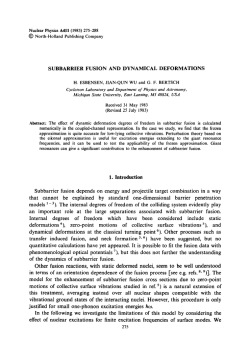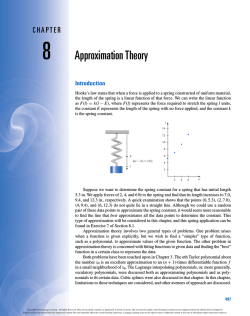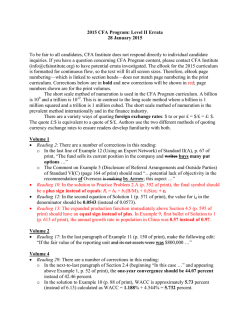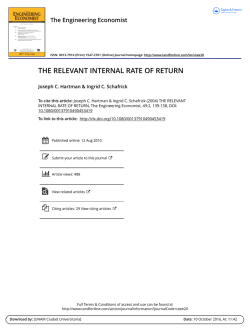
151. - Institute for Nuclear Theory
ANNALS
183, 309-319 (1988)
OF PHYSICS
Static Path Approximation
for the Nuclear
P. ARVE, G. BERTSCH, B. LAURITZEN,
Cyclotron
Laboratory,
Michigan
State
Unioersity,
Partition
Function
AND G. PUDDU
East Lansing,
Michigan
48824
Received November 27, 1987
We propose to approximate the many-body partition function for a system of interacting
Fermions by summing static paths of the Hubbard-Stratonovich
representation. We
demonstrate with a simple two-level model that the approximation is superior to tinite
temperature Hartree theory. Corrections to the approximation to second order in the inverse
temperature are readily evaluated. i! 1988 Academic Press. Inc.
1. INTRODUCTION
The behavior of nuclei at high excitation energy is an interesting topic of study
with new experimental probes available. However, the theory needs to be much
improved from the present state. Standard many-body theory yields the finite
temperature Hartree approximation,
which is applied with a Brueckner or
phenomenological
effective interaction. The main physical shortcoming of Hartree
theory is that the single mean field does not allow enough fluctuations to describe
any sort of fluctuation phenomena at high temperature. Fluctuating mean fields
have been incorporated in an ad hoc manner by computing a free energy surface
in the space of nuclear shape degrees of freedom [l].
We would like an
approximation that contains the same physics, but can be derived from a systematic
theoretical framework.
The Hubbard-Stratonovich
repesentation [2], of the partition function seems to
provide a suitable framework. The Hartree approximation is contained as a definite
approximation
to the path integral. Namely, one replaces the integral by the
integrand for this path. In our approximation
we also start with static paths, but
integrate over all such paths rather than simply take the most important. Since each
static path is identical to a mean field configuration, the approximation
in some
way sums over fluctuations in the mean field. It should therefore be superior to a
single-field approximation.
Our interest in this method is due to our belief that the technique can be applied
to semi-realistic nuclear Hamiltonians.
The integration over paths would be done
by a Monte Carlo sampling method. Essentially, the work involved corresponds to
calculating a single Hartree-Fock
iteration for each sampled path. This would
require considerably more work than is done in present calculations, but it is not
out of bounds of what can be contemplated with present-day computers. Before
309
0003-4916/88 $7.50
CopyrIght ct 1988 by Academic Press. Inc.
All rights of reproduction
m any form reserved.
310
ARVE ET AL.
embarking on a lengthy project using this approximation,
we need to have some
idea of its utility. In the paper, we apply the method to a simple model Hamiltonian
to see how well it works.
In Section 2, the static path approximation
to the partition function is defined. It
is applied to the model Hamiltonian
in Section 3. Higher order corrections are
discussed in Section 4, while comparison with Hartree calculations is discussed in
Section 5. Section 6 contains some concluding remarks.
2. PARTITION
FUNCTION
IN HUBBARD-STRATONOVICH
REPRESENTATION
The starting point of our discussion is the functional representation of the
partition function. For simplicity we will consider the grand canonical partition
function
z=
tr{e-P(fi-P@‘},
(2.1)
where fi is the particle number operator, fi the Hamiltonian
of the system, and /I
the inverse temperature. We will refer to /l as the time variable, due to the similarity
of the exponential in (2.1) with the evolution operator.
We now require that the Hamiltonian
be the sum of a one-body operator, 8, and
two-body interactions that can be written as a negative definite quadratic form in
one-body operators 6,)
k=R-1
L,bJ,,
(2.2)
A,>O.
z
The exponential in Eq. (2.1) is replaced by the Trotter product of L time slices, and
the exponential on each slice is expressed as an integral over one-body
Hamiltonians
using the Hubbard-Stratonovich
transformation.
The partition
function then has the appearance
(2.3)
where 1 labels the time slices. The one-body Hamiltonian
h[a(t)]=R-C
h is given by
2A,a,(t)fi,.
(2.4)
z
The field variables
o,(t)
thus appear
as single-particle
potentials,
and the
STATIC
PATH
311
APPROXIMATION
integration of (2.3) is taken over all values of the fields. The limit of Eq. (2.3) as the
width of the time slices p/L goes to zero is written formally as a path integral,
z = j D[a] t?sen[u’
(2Sa)
in terms of the effective action
Here T denotes the time-ordering operator. Equation (2.5) will be referred to as the
continuous time limit. The trace is taken over the many-body states of the system.
In the grand canonical ensemble, the trace reduces to the determinant [3]
tr{Texp(-1:
dt (&a(t)]
where U, is a matrix representation
- pfi) )i=det(l+U,),
of the single-particle
evolution
-L P (h[a(t,)]
(2.6)
operator,
-p)
(2.7)
In general, the evolution operator is untractable and an approximation scheme is
required to evaluate the effective action (2.5). One approximation
would be to
expand the functional h[a] as a Taylor series around the static field, rr”, which
yields the maximum of the effective action. However, only the zeroth order term is
easily evaluated. Namely, the determinant becomes trivial in the basis of eigenstates
of the single-particle matrix /~[a’],
Wl + Uu)=fl (1 +w(-P(&k-pC1))),
(2.8)
k
where &k are the eigenvalues of h[o”]. This would give the Hartree solution for the
partition function, while the second order terms give the RPA corrections [4].
However, the approximation
may be largely improved, by noting that the
relation (2.8) applies to all time-independent
paths cr. We therefore expand the
effective action (2.5) as a power series around the static path
(2.9)
which is defined for each path o,(t). Here 5, is the average of o,(r)
8. The expansion is formally similar to the well-known expansion
field, but is carried out here for all constant values of the field.
approximation
is obtained by considering only the static paths
over the interval
about the mean
The static path
in the evolution
312
ARVE ET AL.
operator. Corrections to the static path approximation
are taken into account by
considering fluctuations of the Hubbard-Stratonovich
field around the static
paths c,.
In the static path approximation,
the integration is performed over the variables
5,. We therefore need a transformation to a new set of variables that contains 8,.
This may be done conveniently by Fourier-expanding the fields a,(t,). For L finite
and odd, we may write
n=(L-I)/2
aa(
n=
1
-(L-I)/2
c,,,exp
(
i?l
1
,
c,, --n = CL?
(2.10)
noting that o,(t) is real. The integration is performed over the fields c,,~, Re(c,,),
Im(c,,,), n = 1, .... (L - 1)/2, where the field c,,~ is equal to 5,. For small fluctuations the single-particle Hamiltonian
h[a] is split into two parts,
J44t,)l = k?+Mt,)
(2.11)
h,.(t,) = - 1 c 2Q,2
n>o z
Re [ c .,new(iFl)],
and h,. is treated as a perturbation. The exponential
c2.” including up to quadratic terms
lim
L+3c
fl exp
(
,
= exp(
-f
- flh,)
of h, is expanded in powers of
hCdz,)l
)
-
jP
0
dt exp( - th,) h,.(t) exp( - (/? - t) h,)
+ ‘dt ‘df’exp(-th,)h,(t)exp(-(t’-t)h,)h,(t’)exp(-(p-tf)h,).
s0 sI
(2.12a)
Here h,.(t) is the continuum
limit of (2.11)
k.(t)= - II>0c 1I %A
2 ReCc,, exp(iw,t)l,
o,=-.
2m
B
(2.12b)
Taking the trace of (2.12) causes the second term on the right hand side to vanish.
Thus corrections to the static path approximation are of quadratic or higher order
terms in the fluctuating fields. However, when evaluating the trace as a determinant, cf. Eq. (2.6), the term in Eq. (2.12) that is linear in h, must be included in
STATIC PATH APPROXIMATION
313
the determinant for the relation (2.6) to be valid to second order in h,. The
integrals (2.12) are evaluated by working in a basis that diagonalizes the matrix
representation of h,. This is carried out in a model calculation in Section 4.
Keeping only the first term of the expansion (2.12) yields the static path
approximation
to the partition function
Expectation values treated in this approximation
are amenable to Monte Carlo
sampling. Note that static solutions of the mean field are included in the integration
domain of (2.13). Thus (2.13) has the potential to be a better approximation
to Z
than the usual mean-field theory, especially if contributions from several mean field
solutions are important.
The static path approximation
is exact when the kinetic and the potential energy
operators in (2.2) commute. In the limit of high temperature, i.e., for /I + 0, one can
neglect the noncommutativity
between these operators, the error in the partition
function being of the order j3. Therefore the proposed approximation
gives the
correct high temperature limit.
3. APPLICATION
TO A MODEL
HAMILTONIAN
The technique
of the Hubbard-Stratonovich
transformation
and the
approximation
of the partition function introduced in the previous section can be
elucidated in a simple two-level model. The Hamiltonian
is taken to be
H’= g- &j2,
k=d(&fi,)
E”> 0
(3.la)
fi=a++a,
where
(3.lb)
The number of particles is given by N, as for half-filled shell. In the grand canonical
ensemble, Eq. (2.1), this corresponds to having a chemical potential p = 0, independent of temperature.
The choice of the Hamiltonian
is motivated by the similarity of a Nilsson
Hamiltonian
plus a quadrupoleequadrupole
interaction [ 51 and allows comparison
314
ARVE
ET AL.
with an exact solution. As in the Lipkin-Meshov-Glick
model [6], the solutions to
the Hamiltonian
(3.1) can be characterized by quasi-spin quantum numbers. The
operators at, A, and $(fii -N2) obey the angular momentum
commutation
relations of J, , J--, and J,, respectively. With the use of these quasi-spin operators
the Hamiltonian
(3.1) may be written
H = - 4l(J,)2
- 2dJ;.
(3.2)
The total angular momentum J is a constant of motion. For the lowest energy
eigenstate it is given by the maximum value of the z-component, J= J,,,,, = N/2.
In the form (3.2), the Hamiltonian
can be given a nice geometrical interpretation
of a single particle of angular momentum J in a quadrupole, oblate deformed
nucleus with symmetry axis x, and cranked with the frequency 2d around the z-axis
[7]. In the large N limit, the solution of the Hamiltonian
may be obtained by a
semiclassical approximation.
Namely, the trajectory of the motion of the angular
momentum vector is given by the intersection of the parabolic cylinder (3.2) and
the sphere,
J’=J;+J.;+J;.
(3.3)
The minimum
energy solution is given in Table I. Note that for frequencies
2d < 8,?J, the Hamiltonian
possess two degenerate minima of opposite signs of J,,
while at frequencies 2d> SAJ, only one minimum appears, at J, = 0. Thus a phase
transition occurs with the order parameter (J,) when the frequency 2d is increased
beyond 815. In the following, it is shown that this phase transition also occurs when
the temperature is increased to T= 215. This is similar to the BCS theory for
pairing phase transitions.
The partition function in the Hubbard-Stratonovich
transformation (2.3) is
Z= L+K,
lim (y22-112j
dc, n>*
n d Re(c,) d Im(c,)
xexp(-/?1&2~.F,,~c~~2)Tr{Texp(-~~d~(&+h.))},
TABLE
Minimum
2d < 8iJ
2d>
81J
Energy Solutions
the Semiclassical
I
of the Hamiltonian
Approximation.
J,
J:
+(J*-8/1622)“2
d/4/1
0
(3.4a)
J
(3.2)
in
E
- 4w
- dzpz,
- 2dJ
STATIC
PATH
315
,4PPROXIMATION
where
h, = k-
2&ic,,
h,. = -2&Y
2 Re[c, exp(io,t)].
c
(3.4b)
n>o
The single-particle Hamiltonian
h[o] is diagonal in the indices v, Eq. (3.1), and the
2Nx 2N matrix representation of h[o] is split into N identical 2 x 2 submatrices.
The static path approximation to the partition function is obtained by neglecting h,
in Eq. (3.4) and applying the relations (2.6), (2.8). The integral over c,, n #O, is
trivial, yielding
d6 exp( -P;i(c?)*)(l
+co~h(flS))~
(3.5)
s= (d2 f (210)‘)“2.
We evaluate the remaining integral in the stationary phase approximation.
For
small values of 8, N&I < 1, the integrand in (3.5) has a maximum at 6 = 0, and the
partition function becomes
From the partition function, we can obtain the total energy. At high temperature,
T > NJ, the energy can be expanded in powers of /I,
E,=
--$(lnZ,)=
-~N~-~Nd2~-~(Nl.)2i(.-~(N~)3~2+~Nkf2~2+0(B3).
(3.7)
When the temperature is decreased, the stationary point 6 = 0 becomes a local
minimum of the action. In the limit /-3-+ cc and for d < 2NL, the integrand has two
symmetric
maxima
at C!= f dm.
Again, the stationary
phase
approximation
may be applied to give
(3.8)
and the ground state energy is obtained,
E,= -h”i-$,
d < 2NA.
This is equivalent to the semiclassical result obtained above, cf. Table I. Note that
the ground state energy is given by the mean field only. That is, the quadratic
correction given by the last term in (3.8) does not contribute to the energy.
ARVE ET AL.
316
4. HIGHER ORDER CORRECTIONS
The second order corrections to the partition
function are readily obtained from
h, and the
integrations are now straightforward but tedious. The resulting expression is
inserted in the effective action (2.5b), which is expanded to second order in the
fields c,, n > 0. The Gaussian integral over these fields is performed, leading to the
partition function
Eq. (2.12). The operator h,. is expressed in the basis that diagonalizes
d6 exp( -/3A(C)2)( 1 + cosh(fis))N
-1
(?)* + t
12)2 tanh@$/2)
n
.
(4.1)
It is instructive to obtain this result, making use of a technique discussed in
Ref. [8 J where it is applied to real time evolution operators. We are looking for the
eigenvalues of the evolution operator
dt(h, + h,.) dk = ePPEkdk.
Instead of solving (4.2) directly, we note that the states
(4.3)
are solutions to the equivalent
boundary value problem
(4.4)
The complete set of solutions to (4.4) is given as
IC/k.n(t) = $k(t) ev(h,t),
Ek,n
=
&k +
io,.
(4.5)
From (4.4), (4.5), we can obtain the energies ek as a perturbation expansion in the
interaction h,.. We write .sk= Edco)+ ci2), where the unperturbed energies .si”) are the
and
eigenvalues of h,, the corresponding eigenstates $, co) being time-independent,
ek2) are the second order energy terms
(4.6)
317
STATIC PATH APPROXIMATION
In (4.6) the matrix element of h, involves integration
Eq. (3.4) the energies become
Eli= + St (4i)$
(
p2
1
n>O(w2+4
over time. Inserting
).
h, from
(4.7)
Making use of (2.8), we can now expand the effective action to second order in c,.
Again, performing the Gaussian integrals over c,, n > 0, leads to the result (4.1).
The last term in Eq. (4.1) stems from the second derivative of the action with
respect to c,, and the expression is valid only when the second derivative is
negative definite. Thus the Gaussian integral diverges for a certain range of
parameters, when the last term contains negative factors, implying that quartic or
higher order corrections may be important for evaluation of the correction to the
static path approximation.
In this case, the static path approximation
does not
sample the optimal paths of the partition function.
At high temperatures however, PNL < 1, the second order correction converges,
which is also the case when evaluated at the stationary mean field solution for
smaller temperatures. As in Eq. (3.7), the energy may be expanded in powers of /?.
This leads to a correction of the energy of second order in fi
E,=E,+E,
E,. = - iN3,d2P2+ o(B3),
/INI- < 1.
(4.8)
The energies obtained with the use of the Hubbard-Stratonovich
transformation
may be compared to an exact calculation. This has been carried out in the
canonical ensemble. Noting that all terms of the energy expansion in j? (4.8) contain
quadratic or lower orders in d, the exact energy has been calculated including
second order terms in the kinetic energy g. Doing so, agreement up to order l/N
with the results (3.6), (4.8) is obtained. This suggests that the approximations
applied here contain all terms in the energy expansion up to second order in 8.
It is noted from the energy expansion in j?, that approximating
the
Hubbard-Stratonovich
fields by time-independent
fields becomes a good
approximation in the large N limit. This is essentially in agreement with the success
of mean-held theories in heavy well-deformed nuclei. At small values of N,
however, and for not too high temperatures, the time fluctuations of the
Hubbard-Stratonovich
fields become important,
as seen from the energy
correction (4.8).
5. COMPARISON
TO FINITE TEMPERATURE
HARTREE AND HARTREE-FOCK
THEORY
Nuclear microscopic calculations at high excitation energy have traditionally
been carried out with the finite temperature Hartree or Hartree-Fock approaches,
595/183/2-9
318
ARVE
ET AL.
It is therefore instructive to compare these techniques with the HubbardStratonovich transformation
in the static path approximation,
as applied to the
present model.
The Hartreee and the Hartree-Fock single-particle Hamiltonians
may both be
obtained as mean-field solutions to the path integral [9]. This is accomplished by
adding linear terms in the fields a,(t,), in the Trotter expansion of the evolution
operator. Although adding such linear terms does not change the path integral
carried out in the full space of the auxiliary fields a,(t,), it alters the constant path
approximation
to the integral. In the present formulation,
the constant path
approximation contains as stationary paths the Hartree mean-field solutions, while
the connection to Hartree-Fock is unclear.
The Hartree solution to the partition function are obtained by replacing the
integrand of Eq. (3.5) by its maximum value, that is, neglecting the correction factors in Eqs. (3.6), (3.8), stemming from the quadratic corrections. At temperatures
above the phase transition, T> N& the Hartree mean field is given by 5 = 0, and
from Eq. (3.6), the Hartree energy is readily obtained,
EH = - -$ (In Z,) z -;N~‘/?+o(~~),
(5.1)
much different from the result (3.7). For /I -+ co and d-c 2NJ, the ground state
energy (3.9) is obtained from the Hartree solution, as discussed below Eq. (3.9).
In the present model, the Hartree-Fock equations are easily solved. Noting that
the Hamiltonian
(3.1) is symmetric under any permutation of the indices v, the
finite temperature Hartree-Fock Hamiltonian
is given as
where
V +,,.+)/= v-,,_.s=
(M+,,+,,=
(h,)-,,-,.
-22,
= i, b(v, v’)
and lj>, Ik) are the single-particle
(3.11,
I+v)=~(llv>+l2v)),
&
V +“,-“‘=
(ho)+,,.-,,=
v_,,+,,=2A.
(ho)-,,+,.=4
wavefunctions that diagonalize
I-v>=&lv>-12v)).
&
(5.2b)
&v, v’)
the interaction
fi
(5.3)
The Fermi occupation numbers, f, = (1 +exp(/?s,)))‘,
are given by the HartreeFock energies E,, and the states 1t) denote the single-particle eigenstates to the
Hartree-Fock Hamiltonian.
For temperatures above the phase transition, T> NA,
319
STATIC PATH APPROXIMATION
and for d < AN, all Hartree-Fock
energy is given as
energies become degenerate, E, = 0, and the total
EHF= -;
NJ.,
/k&.
(5.4)
Thus, the Hartree-Fock approximation lacks a /&expansion of the energy and only
the constant term in Eq. (3.7) is obtained in the high temperature limit.
6. CONCLUSIONS
We have shown that the static path approximation in the Hubbard-Stratonovich
representation of the partition function is useful to treat a simple Hamiltonian
similar to the Lipkin-Meshov-Glick
model. At high temperature, the static path
approximation
is superior to the finite temperature Hartree approximation.
Our
static path treatment is also superior to Hartree-Fock, which in the present model
is diseased and does not have a high energy expansion. We recently learned of a
similar study of the Lipkin model by Alhassid and Zingman [lo]. These authors
consider only the Hamiltonian
subspace of maximally symmetric configurations.
Their conclusion which is similar to ours, is based on numerical comparison with
their exact partition function.
We also examined second order corrections to the static paths. These corrections
at lower
are well-behaved at high temperatures, but become uncontrollable
temperatures. Despite this, the static path approximation is rather accurate as the
temperature goes to zero. In any case, one must be cautious in low temperature
applications. We are encouraged by the overall utility of the approximation
to
apply it to a more realistic model. We are now considering models with a three
dimensional spatial structure and separable interactions, that reduce to Nilsson
Hamiltonians
in the Hartree approximation.
ACKNOWLEDGMENTS
This work was supported by the NSF under Grant PHY-8519653.
additionally by a grant from the Carlsberg Foundation.
B. Lauritzen
is supported
REFERENCES
1. M. GALLARDO,
2. J. HUBBARD,
M.
T. DOSSING,
AND R. A. BROGLIA,
Nucl.
Phys. A 443 (1985), 415.
Lett. 3 (1959), 11; R. L. STRATONOVICH,
Dokl. Akad. Nauk. SSSR
(1957) 1097 (trans. Son Phys. Dokl. 2 (1958). 416).
3. R. BLANKENBECLER.
D. J. SCALAPINO,
AND R. L. SUGAR,
Phys. Rev. D 24 (1981), 2278.
4. A. K. KERMAN
AND S. LEVIT, Phys. Rev. C. 24 (1981), 1029.
Phys
DIEBEL,
Rev.
AND P. SCHUCK,
“The Nuclear Many-Body Problem,” Springer-Verlag,
H. J. LIPKIN, N. MESHOV, AND A. J. GLICK, Nucl. Phys. 62 (1965), 188.
A. BOHR AND B. R. MOTTELSON,
Phys. Ser. 22 (1980) 461.
8. S. LEVIT. J. W. NEGELE,
AND Z. PALTIEL,
Phys. Rev. C 21 (1980) 1603.
9. A. K. KERMAN,
S. LEVIT, AND T. TROUDET,
Ann. Phys. 148 (1983), 436.
10. Y. ALHASSID
AND J. ZINGMAN,
Phys. Rev. C 30 (1984) 684.
5. P. RING
6.
I.
115
New York, 1980.
© Copyright 2025









